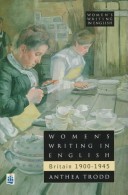Women's Writing In English
1 total work
In this work, the author presents a history of women's writing in Britain between 1900 and 1945. In the first years of the Edwardian period, women writers were most prominent in the genres of children's writing and romantic fiction. In the first half of the 20th century, women's writing expanded and diversified into prominence in a range of genres including published autobiography and the new field of academic discourse. Women's writing is considered in its social and cultural contexts and the work charts the transition of women's writing from the Edwardian period to the Modernist period. It also looks at the history of the relations, whether helpful, emulative or dismissive between women writers such as Viginia Woolf and Berta Ruck. It also seeks to shed light on the shared themes and concerns of innovative, "lowbrow" and "middlebrow" writers - that they had to contend with the gulf between their perception between themselves as professional and the public perception of "lady writers".
